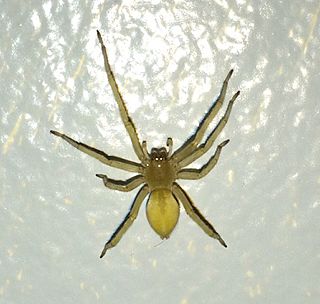
Cheiracanthium inclusum, alternately known as the black-footed yellow sac spider or the American yellow sac spider, was formerly classified as a true sac spider, and then placed in the family Miturgidae, but now belongs to family Cheiracanthiidae. It is a rather small pale yellow species that is indigenous to the Americas. It is often found living in the foliage of forests and gardens but also can inhabit human homes. Despite common beliefs of necrosis, Cheiracanthium bites cause only localized swelling. C. inclusum is closely related to Cheiracanthium mildei, an introduced species native to Europe which is similar in appearance and natural history and can also be found in North American homes.

The Pholcidae are a family of araneomorph spiders. The family contains more than 1,800 individual species of pholcids, including those commonly known as cellar spider, daddy long-legs spider, carpenter spider, daddy long-legger, vibrating spider, gyrating spider, long daddy, and angel spider. The family, first described by Carl Ludwig Koch in 1850, is divided into 94 genera.

Crevice weaver spiders (Filistatidae) comprise cribellate spiders with features that have been regarded as "primitive" for araneomorph spiders. They are weavers of funnel or tube webs. The family contains 18 genera and more than 120 described species worldwide.
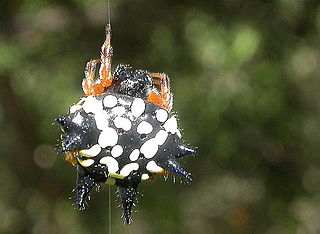
Austracantha is a genus of spider with a single species, Austracantha minax, commonly known as the jewel spider or the Christmas spider. It is a member of the family Araneidae and is endemic to Australia. They are relatively small spiders, reaching a maximum total body length of only around 12 mm (0.47 in) for females, and 5 mm (0.20 in) for males. Their abdomen has six distinctive projections ("spines") that makes them easy to identify. They are predominantly a shiny black, with variable white, yellow, and orange patterns. Melanistic forms also occur during autumn. They are facultatively gregarious, and can be found in large aggregations of overlapping orb webs. They feed on small flying insects that get entangled in their webs. They are harmless to humans, though the webs can be a nuisance for bushwalkers. They are most abundant during the summer months.

The spider species Tegenaria domestica, commonly known as the barn funnel weaver in North America and the domestic house spider in Europe, is a member of the funnel-web family Agelenidae.
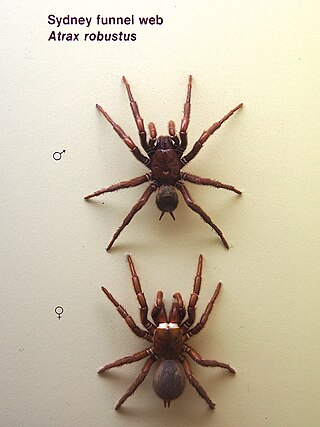
The Sydney funnel-web spider is a species of venomous mygalomorph spider native to eastern Australia, usually found within a 100 km (62 mi) radius of Sydney. It is a member of a group of spiders known as Australian funnel-web spiders. Its bite is capable of causing serious illness or death in humans if left untreated.
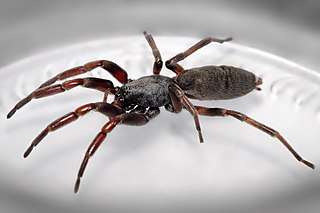
White-tailed spiders are spiders native to southern and eastern Australia, and so named because of the whitish tips at the end of their abdomens. The body size is up to 18 mm, with a leg-span of 28 mm. Common species are Lampona cylindrata and Lampona murina. Both these species have been introduced into New Zealand.

Steatoda grossa, commonly known as the cupboard spider, the dark comb-footed spider, the brown house spider, or the false widow or false black widow, is a common species of spider in the genus Steatoda.

Argiope aurantia is a species of spider, commonly known as the yellow garden spider, black and yellow garden spider, golden garden spider, writing spider, zigzag spider, zipper spider, black and yellow argiope, corn spider, Steeler spider, or McKinley spider. The species was first described by Hippolyte Lucas in 1833. It is common to the contiguous United States, Hawaii, southern Canada, Mexico, and Central America. It has distinctive yellow and black markings on the abdomen and a mostly white cephalothorax. Its scientific Latin name translates to "gilded silver-face". The body length of males range from 5–9 mm (0.20–0.35 in); females range from 19–28 mm (0.75–1.10 in). These spiders may bite if disturbed or harassed, but the venom is harmless to non-allergic humans, roughly equivalent to a bumblebee sting in intensity.
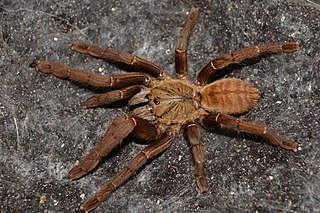
Cyriopagopus hainanus is a species of spider in the family Theraphosidae (tarantulas), found in China. It is one of a number of species from China and Vietnam known as "Chinese bird spider". It produces a venom containing numerous compounds capable of blocking neurotransmitters, including neurotoxic peptides called hainantoxins.

Sphodros rufipes, sometimes called the red legged purseweb spider, is a mygalomorph spider from the southern and eastern United States, though it has been photographed as far north as Minnesota. It has confirmed sightings in Indiana, Missouri, New Jersey, West Virginia, Tennessee, Delaware, Louisiana, and Tuckernuck Island in Massachusetts. One recent sighting shows that these spiders can also be found in Canada, while another reveals that they have been spotted in Kansas.
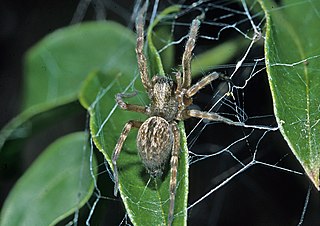
Badumna is a genus of intertidal spiders that was first described by Tamerlan Thorell in 1890. They are harmless spiders that can be found around human structures and buildings. The most well-known species is B. insignis, also known as the "black house spider" or "black window spider".

Oecobius navus is a small cosmopolitan cribellate spider species found across the world.

Porrhothele antipodiana, the black tunnelweb spider, is a species of mygalomorph spider that lives in New Zealand. It is the most common and widespread of several species in the genus Porrhothele, and is especially common in the greater Wellington region where the vagrant mature males are often encountered in or around dwellings. This species is one of New Zealand's most studied spiders. In New Zealand, the common name "tunnelweb spider" is also often used to refer to members of the genus Hexathele. Neither should be confused with their distant relatives, the highly venomous Australian funnel-web spiders.

Hexathele hochstetteri, commonly known as the banded tunnelweb spider, is a spider in the family Hexathelidae, found only in New Zealand. It is common on the North Island, and uncommon on the South Island.

Sidymella rubrosignata is a species of crab spiders found in Australia. It is a common spider, often seen on Dianella plants.

Hyptiotes paradoxus, also known as the triangle spider, is a cribellate orbweaver in the family Uloboridae.
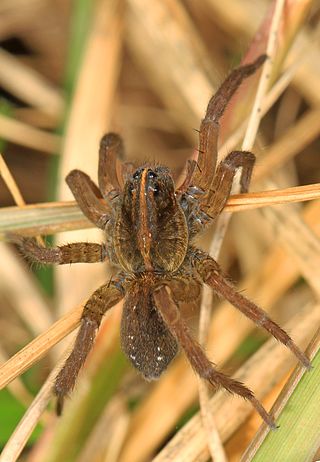
Tigrosa helluo, commonly known as the Wetland Giant Wolf Spider, is a species of spider belonging to the family Lycosidae, also known as wolf spiders. T. helluo was formerly known as Hogna helluo before differences between dorsal color patterns, habitat preferences, body structures, etc. were discovered. The species is native to the United States, Canada, and Mexico. It can be found across the eastern half of the United States, primarily in the Northeast and New England, and as far west as Nebraska and Kansas. T. helluo can be found in diverse habitats including woods, marshes, fields, and riparian areas. Typically, members of this species prefer to live in wetter areas as opposed to dry environments. Males tend to live for around a year and females will live for close to two years.

Argiope aemula, commonly known as the oval St Andrew's cross spider, is a species of spider in the family Araneidae which is native to southeast Asia, found from India and Sri Lanka to the Philippines, Indonesia, and Vanuatu. It is one of the giant, conspicuous "signature spider" species of the genus Argiope, observed in tropical and subtropical grasslands.
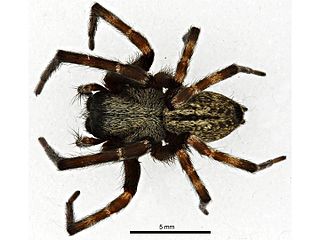
Badumna longinqua or the grey house spider is a species of spiders in the family Desidae. Native to eastern Australia, it has been introduced into New Zealand, Japan, the United States, Mexico, Uruguay and the Netherlands.






















